Hassan Ibrahim | Muhammed Fansa
The massive 7.7 magnitude earthquake that struck southern Turkey and four Syrian governorates changed the lives of Syrians residing in ten Turkish states that were affected by the “disaster of the century,” which resulted in more than 43,000 deaths, in an endless toll, within a “stricken” geographical area in which about 1,750,000 Syrian refugees live under the roof of “temporary protection.”
Syrian souls lost their breath under the rubble, and death was an inevitable fate, and others left, and the means of life were narrowed down and gave them limited options after a severe disaster that affected tens of thousands without exception.
The tragedy was multiplying on the Syrians living in those areas, most of whom work on the minimum wage, without the possibility of saving funds for times of crisis.
Accumulated needs arose for Syrians looking for housing, food, medical services, and legal papers, amid fears of human rights organizations related to the right to life, ill-treatment, and freedom of expression, after an earthquake that did not stop the racist discourse against Syrians in Turkey.
In this file, Enab Baladi sheds light on the difficult situations of the Syrians as a result of the earthquake in Turkey and reviews the testimonies of those affected and the method of documenting the unidentified victims and the destinations that the Syrians took or that were imposed on them by the circumstances of the disaster, and the amount of support provided, whether by the authorities or non-governmental organizations.
Two ways to the grave
The path to the grave was not the same for the Syrians, as the victims’ bodies were transferred to mass graves dug by the Turkish authorities, and others were brought back to northern Syria for burial.
There are no accurate statistics for the number of Syrian victims in ten “affected” Turkish states, which include about 1,750,000 people out of 3.5 million in Turkey under the temporary protection card (Kimlik).
The 7.7 magnitude earthquake and its aftershocks, including a major one nine hours after the initial temblor, struck southeastern Turkey and northern Syria on Feb. 6, reducing huge swaths of towns and cities to fragments of concrete and twisted metal. The death toll has surpassed 50,000, according to the AP.
A day after the massive earthquake, Turkish President Recep Tayyip Erdogan declared a three-month state of emergency in ten “afflicted” Turkish states, describing it as “one of the biggest disasters not only in the history of Turkey but also in the region and the world.”
On the first day of the earthquake, Erdogan signed a circular declaring general mourning throughout the country for a period of seven days due to the earthquake so that the Turkish flags would fly at half-mast inside the country and in the foreign representations.
Numbers not names
Wooden planks, each of which has a number without a name on it. The lower part of it is stuck into the dirt floor crowded with the bodies of the earthquake victims in the Narlıca region on the main road between Antakya and Reyhanli in southern Turkey.
“117” and “118” were not just two ordinary numbers for the Syrian youth, Abdullah Masri, and his family, as they are the only documentation indicating the graves of his uncle and his wife, who were among the victims of the devastating earthquake.
With the passage of the fifth day after the earthquake, the young man and rescue teams were able to extract the bodies of his uncle and his wife from the rubble of their home in Antakya and moved them for burial in the cemetery that was created for the earthquake victims in the neighboring state of Narlıca.
Masri explained to Enab Baladi that the bodies of the victims in Antakya were transferred to the newly created mass grave in Narlıca, and they were documented by forensic medicine teams and shrouded if the bodies were fit for shrouding.
Information about identified victims was filled out by their relatives on a sheet of paper, and each corpse was given a number to be buried in the cemetery, with the presence of a burial team and a team from the Turkish Religious Endowment, who conducted the funeral prayer, according to the young man.
The sheet is filled in with information on the victim’s name and other details such as address and house number.
As for unknown corpses, Masri said that the forensic teams took pictures of them, regardless of whether their physical appearance was clear or not, and took samples from the corpse through needles from the neck and thigh area, then carried out the same steps of shrouding and praying.
A sworn criminal expert working in the forensic medicine department in the city of Azaz in the countryside of Aleppo, Dr. Mohammad Kahil, explained to Enab Baladi that the DNA related to an individual’s genetic makeup can be taken from any cell in the human body that carries genetic characteristics, whether from a skin scraper, the hair, the muscle, or from the nail.
After taking the sample, it is preserved and archived. When relatives search for the bodies of their family members, a sample of their missing relative is taken from them (from the remains of the missing persons’ belongings), and the two samples are compared with each other.
Crossings open for corpses
The second route taken by the bodies of the Syrian victims was the border crossings separating Turkey from Syria, which received on a daily basis funeral cars loaded with dozens of corpses to be buried in northwestern Syria.
As of February 23, the number of deaths of Syrians who arrived from Turkey through the Bab al-Hawa crossing reached 1,570, according to the latest statistics published by the crossing administration.
The director of the Bab al-Salama crossing, Brigadier General Qassem al-Qassem, told Enab Baladi that the death toll from the earthquake among the Syrians whose corpses entered through the crossing had reached 166 people as of February 24. Also, 22 bodies were brought back through the al-Rai border crossing since the earthquake occurred until February 24.
Mazen Alloush, the press officer of Bab al-Hawa border crossing, told Enab Baladi that the burial vehicles of the Turkish Ministry of Health delivered the bodies of many Syrians who were killed in the earthquake to the crossing to hand them over to their families residing in northern Syria.
Alloush said that the families of the deceased are notified by their relatives in Turkey of sending the bodies to northern Syria.
The families of the deceased wait at the crossing gate from the Syrian side to receive them, and the crossing administration does not know the name of the person (the victim) until the funeral car arrives and the body is accompanied by the name of its owner, and the crossing staff works to document the name, Alloush added.

Bodies of earthquake victims in Turkey brought back to northern Syria for burial – February 7, 2023 (Bab al-Hawa crossing)
Narrow corridors
The options of the Syrians who survived the earthquake were not wide, and they did not have the luxury of choosing.
The options are related to securing housing, food, and heating, or moving to other states and entering the spiral of legal papers, medicine, and education, or the option of heading to northern Syria, which the Syria Civil Defense (SCD) team, the Syrian Interim Government (SIG) and the Syrian Salvation Government (SSG) declared a “disaster” area.
The earthquake left 2,274 people killed and more than 12,400 injuries in northwest Syria.
From affected areas to similar ones
Families got out from under the rubble and from cracked buildings that were about to fall in Turkey and entered the north of Syria, which was afflicted by the damage of the earthquake, in the midst of the presence of thousands of families lying on the ground and continuing to search for a shelter tent in an area subjected to almost daily bombardment, the pace of which has recently decreased from Russia and the Syrian regime.
The Bab al-Hawa, Bab al-Salama, Tal Abyad, and Jarablus crossings announced that the earthquake-affected Syrians, holders of the “temporary protection” card, would be allowed to visit the northern regions of Syria on a temporary basis, provided that the duration of their stay in the Syrian territories is not less than three months and not more than six months.
The announcement of the crossings was not in a unified format or at a single time, and the conditions varied, which created a state of loss and dispersion for the Syrians, and fears of not returning to Turkey if the situation stabilized.
The Communications Director of the Syrian-Turkish Joint Committee, Enas Najjar, told Enab Baladi that the visit permission granted by the Turkish Immigration Department is only for Syrians residing in “stricken” areas and only for holders of a “temporary protection card.”
She said that whoever goes through the four border crossings (Bab al-Salama, Tal Abyad, Bab al-Hawa, and Jarablus) from areas other than the “affected” provinces will have their visit considered as a “voluntary return” and will not be entitled to return to Turkey.
It is important, according to Najjar, to adhere to the date specified for the return, and in the event of a delay of six months, the “Kimlik” card will be revoked, and the visit will be considered “voluntary.”
She also denied the existence of any legal concerns about the visit license if the permission conditions are met, and any new law issued will not have a retroactive effect, as the authority that issued it is official.
On February 21, the Turkish Minister of Defense, Hulusi Akar, said that more than 20,000 Syrians have returned to their country since the earthquake occurred in southern Turkey, denying the existence of a movement of refugees from Syria towards his country, without specifying whether their return was for a visit or a “voluntary return.”
No choice, tents and cracked houses
The affected Syrian families in Turkey were not in a better condition than those who went to the north, as their presence was accompanied by decisions, consequences, and circumstances that made staying compulsory for some rather than optional.
On February 7, the Turkish Immigration Administration temporarily canceled the travel permit between the Turkish states, with the exception of Istanbul, for Syrians residing in the areas affected by the earthquake, and the residency of Syrians in other states is considered legal for a period of 90 days.
A week after the issuance of the decision, the Turkish Immigration amended its decision and allowed Syrian refugees coming from the affected areas to head to Istanbul for a period of 60 days on the condition that they inform government institutions, such as the Immigration Department, the District Commissioner and the “Mukhtar” (neighborhood principal), of their residence address.
And whoever came to Istanbul and did not find shelter and has no relatives has the choice between going to the “Binkılıç” shelter in the “Çatalca” region or moving to another state.
Imad Khalil, one of the victims of the earthquake, chose to stay in the tents of Hatay province with his family and relatives because a number of family members were injured during the earthquake and are still in hospitals, and they need help and assistance.
Khalil told Enab Baladi that the other reason for their stay in Hatay is the heavy financial burdens resulting from their movement to other states, as they are more than 50 persons, including children, women, youth, and the elderly.
While the Syrian refugee residing in the state of Hatay, Mohammad Jabali, said that he went with his family to the state of Mersin, because of the presence of relatives and friends there.
Ahmed Deeb’s family, consisting of eight people, took refuge in a tent inside the “12 Şubat” stadium, which turned into a shelter center that includes more than 192 tents in the state of Kahramanmaraş after cracks occurred in the family house.
The family told Enab Baladi that they chose to stay in the shelter center and not go to Istanbul, where their son lives, because a period of 60 days does not constitute a state of stability, and the financial cost of transportation is high.
More than three weeks after the disaster, the Syrian Hassan Mohammad, 31, did not find another solution but to bring back his family from Istanbul and return to live in his cracked house in Kahramanmaraş, but there is no horizon for the end of the state of “homelessness,” as he is forced to stay in a shelter near his damaged home.
Mohammad justified his failure to stay with his family in Istanbul because the legal permit was limited to two months only, in a way that shows the authorities’ unwillingness to allow those affected to settle in the state on the one hand.
On the other hand, he did not want to experience a new displacement after establishing his life and work in Kahramanmaraş for seven years.

A Syrian child stands at the entrance of a tent where he lives with his family in a camp in a public park after his house collapsed as a result of the earthquake that struck Adıyaman province – February 15, 2023 (Reuters)
Double needs
Imbalance in Syrian organizations’ aid
The consequences of the disaster affected every one of all nationalities in the “afflicted” Turkish provinces, but it was multiplied for the Syrians who are considered refugees and live in rented houses and receive minimum wages.
More than 70% of Syrian refugees live in poverty and are vulnerable to exploitation and abuse in countries of asylum, according to the 2021 annual report of the United Nations High Commissioner for Refugees (UNHCR).
Hours after the earthquake occurred, various initiatives were launched, including in-kind and material donations, among others, from local and regional bodies and organizations, in solidarity with the victims of the earthquake in Turkey and Syria, in addition to mobilizing government efforts to respond.
Aid arrived from 102 countries, of which 88 countries participated in field efforts since the first day.
At the national level in Turkey, a civil campaign raised $6,108 billion in which many businessmen, artists, politicians, and NGO officials from all over the country participated, in addition to Syrian businessmen and owners of companies in Turkey.
While the Turkish government, through the Ministry of Treasury and Finance, allocated 100 billion Turkish liras in support of those affected by the earthquake and announced financial support for each family whose house was damaged in the earthquake, at a value of 10,000 Turkish liras, which began to be transferred to the beneficiaries in mid-February, after evaluating their homes.
The financial support was not only intended for homeowners but also included Turkish and Syrian tenants, but this assistance has not yet reached many of them, as monitored by Enab Baladi.
Homeowners in the earthquake zone whose homes were assessed as destroyed or severely or moderately damaged can get 60,000 Turkish liras distributed over 12 months, while tenants will be given 2,000 liras every month for a year as government assistance to rent homes in safe states.
Owners of destroyed or severely or moderately damaged homes will receive 15,000 Turkish liras when moving to another state, in assistance called “Relocation Aid.”
However, the authorities did not announce the start of distribution or the mechanism for the last two aids, or who it includes, such as foreigners or Syrians under “temporary protection.”
Wassim Kassab Bashi, a Syrian lawyer working in Turkish courts, told Enab Baladi that according to the “Foreigners” and “Temporary Protection” laws, a foreigner is treated with the same treatment as a Turkish citizen in terms of humanitarian needs in emergencies and others unless there is a reason for the waiver of protection.
Abdul Aziz al-Saj, a volunteer in the “Iqraa” organization operating in Turkey, explained to Enab Baladi that about 65% of the camp’s population in the Islahiye area in the state of Gaziantep are Syrians, as the organization was working in the food sector for this camp, which is inhabited by about 4,500 people.
Al-Saj described the situation of the tent residents as “tragic,” as he noticed that the residents did not have blankets or mattresses for sleeping, after which the Syrians began to be gradually deported from the camps to other places whose destination they did not know.
The Turkish lawyer, Gülden Sönmez, said there is no provision in the “temporary protection” law that clarifies the nature of dealing with Syrians in disaster situations during a discussion session in Istanbul that Enab Baladi attended.
The session was held by a group of Syrian and Turkish civil society organizations, related to following up on the situation of Syrian refugees affected by the earthquake disaster in Turkey, with the participation of representatives of the Turkish Immigration Department on February 22.
Human rights activist and member of the Refugee Rights platform, Taha al-Ghazi, told Enab Baladi that the efforts of Syrian organizations and associations with regard to those affected by the earthquake focused 80% on securing food and clothing, while the most important thing that the Syrian refugee needs now is shelter.
Al-Ghazi relied on the fact that many Syrian families did not find shelter in safe states with relatives or friends, nor did they have the financial ability to move on their own to another state.
This forced them to stay in their afflicted state, and some Syrian families were also expelled from shelter centers in the states of Mersin and Muğla.
Al-Ghazi assumed that if there had been coordination between the Syrian organizations and associations, the situation of the refugees in terms of shelter and relief would have been much better, explaining that most of the efforts were directed towards Antakya, while other areas did not receive sufficient support.

Tents at the “12 Şubat” stadium, which has been turned into a shelter in Kahramanmaraş, southern Turkey, following an earthquake that struck the area – February 8, 2023 (Anadolu Agency)
Endless racism despite the earthquake
The earthquake, which was followed by more than eight thousand aftershocks, did not silence the voices against the Syrian refugees, some of which were voiced by Turkish opposition parties that feed on the Syrians and the rhetoric directed against them in their project.
Some incidents of verbal and physical attacks against Syrians also appeared, which the speech of the Turkish Minister of Interior, Suleiman Soylu, did not prevent from appearing either.
Soylu said on February 13 that when the earthquake happened, the Turkish opposition accused the Syrians of “theft, rape, and looting. We are all here affected by the disaster.”
“What is the point of separating people based on their race and color?” he added. “Well, if you want this, let us leave the Syrians there in the cold until they die. These people did not steal yesterday, so is it possible for them to wait for the earthquake to steal?”
The volunteer in the “Iqraa” organization, Abdul Aziz al-Saj, mentioned that he and his fellow Syrian volunteers were subjected to racist treatment despite their assistance, as members of other Turkish charitable organizations accused them of favoring Syrians in providing aid.
“Syrians must get out of here,” this phrase was repeatedly heard by Syrian volunteers who were students who responded to the disaster. They also became subject to inspections by the Turkish police, which transformed their work from search and rescue to attempts to defend themselves and confirm their desire to provide assistance only.
Amnesty International recommended in a report issued on February 23, guaranteeing the rights of people in need of international protection because of their status as refugees and asylum seekers, especially after reliable news was received from Turkey stating that Syrian refugees are being targeted by both civilians and state actors.
Syrian refugees are targeted, according to Amnesty International, with physical abuse and verbal harassment in racist attacks or through hate speech.
Amnesty also indicated that the refugees were expelled from the camps to house Turkish survivors.
The Turkish authorities should not engage in scapegoating or tolerate abuse by others and should address racism and discrimination by imposing protection procedures against threats.
A member of the Turkish Refugee Rights platform, Yıldız Önen, co-organizer of the discussion session, which was attended by Enab Baladi, said that “the atmosphere of solidarity and helping each other prevailed in society during the first days of the earthquake, but attacks on Syrians began later after some racist provocations.”
Önen explained that before the Syrians could overcome the shock of the earthquake, they were subjected to looting and false accusations, such as giving them priority in aid distribution.
A report by the Syrian Justice and Accountability Center (SJAC) published on February 23 stated that Syrian refugees were forced to ride buses to unknown destinations, and in other places, some aid workers refused to distribute vital materials such as medicines and tents to affected Syrians.
Who fills the void
Human rights activist Taha al-Ghazi warned that the Syrian refugee community during the coming period would go through a “vacuum phase” because the Turkish government will focus its efforts on its citizens and projects for the reconstruction of the stricken areas.
Al-Ghazi told Enab Baladi that organizations representing Syrian refugees from the National Coalition for Revolutionary and Opposition Forces (Syrian National Coalition) or the Syrian Interim Government (SIG) and civil society organizations must fill this void.
Al-Ghazi believes that the Turkish preoccupation could push the refugees to return to northern Syria or head to Europe, calling on Syrian and international bodies to support the Syrian refugees.
In 2022, the European Commission provided the Turkish government with financial packages estimated at 1.2 billion euros to support social integration, while Syrian institutions must coordinate with the Turkish government to direct these packages towards relief support, according to al-Ghazi.
The activist who specializes in refugee affairs raised several problems that Syrians coming from earthquake-affected states will suffer from, such as the instability in Istanbul province after the authorities’ decision to grant permission for only two months to reside there, while it is impossible to return to their affected states.
Problems will also arise for the rest of the states, such as how can the affected Syrians enroll their children in schools, or receive treatment in government hospitals, since the authorities enable only the owners of “Kimlik” extracted from the same state to benefit from social and medical services.
For her part, Enas Najjar, communications director of the Syrian-Turkish Joint Committee, told Enab Baladi that the committee affiliated with the Syrian National Coalition is a voluntary, non-financial committee that plays an organizational role between the institutions and support organizations and the Syrians affected by the earthquake.
Regarding the activities of the committee in supporting those affected, Najjar confirmed that the committee was in contact with the Turkish Immigration Department to allow the afflicted Syrians to travel from their states without the need for a travel permit in the first days of the disaster, and later to include the city of Istanbul among the available states.
The committee provided the Ministry of Interior with lists of people and volunteer teams willing to help the afflicted in northern Syria.
The joint committee with the Turkish Ministry of Interior is seeking to find out the names of missing persons, especially children who have lost their parents, in order to deliver them to their families.
With regard to education, the committee contacted the Turkish Ministry of Education in order to find out the mechanism for registering and supporting Syrian children coming from the affected states, including those who went to northern Syria.
It was also proposed to allocate a mechanism to continue their education remotely and to talk with the Ministry of Higher Education in order to postpone tuition for university students.
Najjar reported that the committee received preliminary approval from the European Union on a proposal to allocate a financial card similar to the Turkish Red Crescent’s debit card to support those affected by the earthquake and to raise the amount of the financial subsidy for the Red Crescent’s card in proportion to the size of the economic inflation.
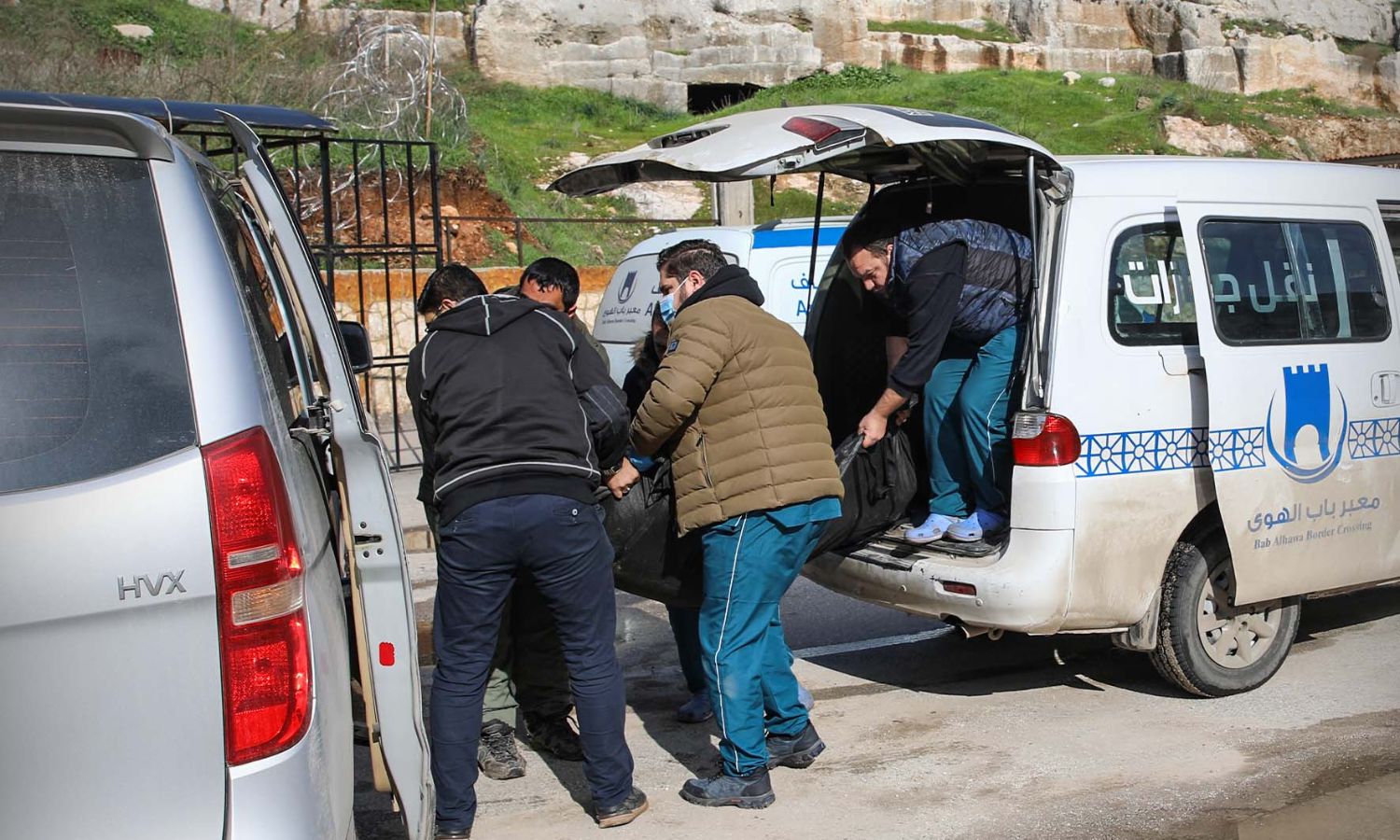
People carrying the bodies of earthquake victims that entered through the Bab al-Hawa border crossing for burial in northwestern Syria – February 7, 2023 (Facebook/Bab al-Hawa crossing)
if you think the article contain wrong information or you have additional details Send Correction
النسخة العربية من المقال
-
Follow us :
Most viewed
- Printing Syrian currency in Europe... A file on the table
- AANES insists on decentralization in Syria
- Al-Sharaa attends 4th Antalya Diplomacy Forum
- Black market traders manipulate dollar prices under eyes of Central Bank officials
- Books make a comeback in Damascus libraries after being banned under Assad












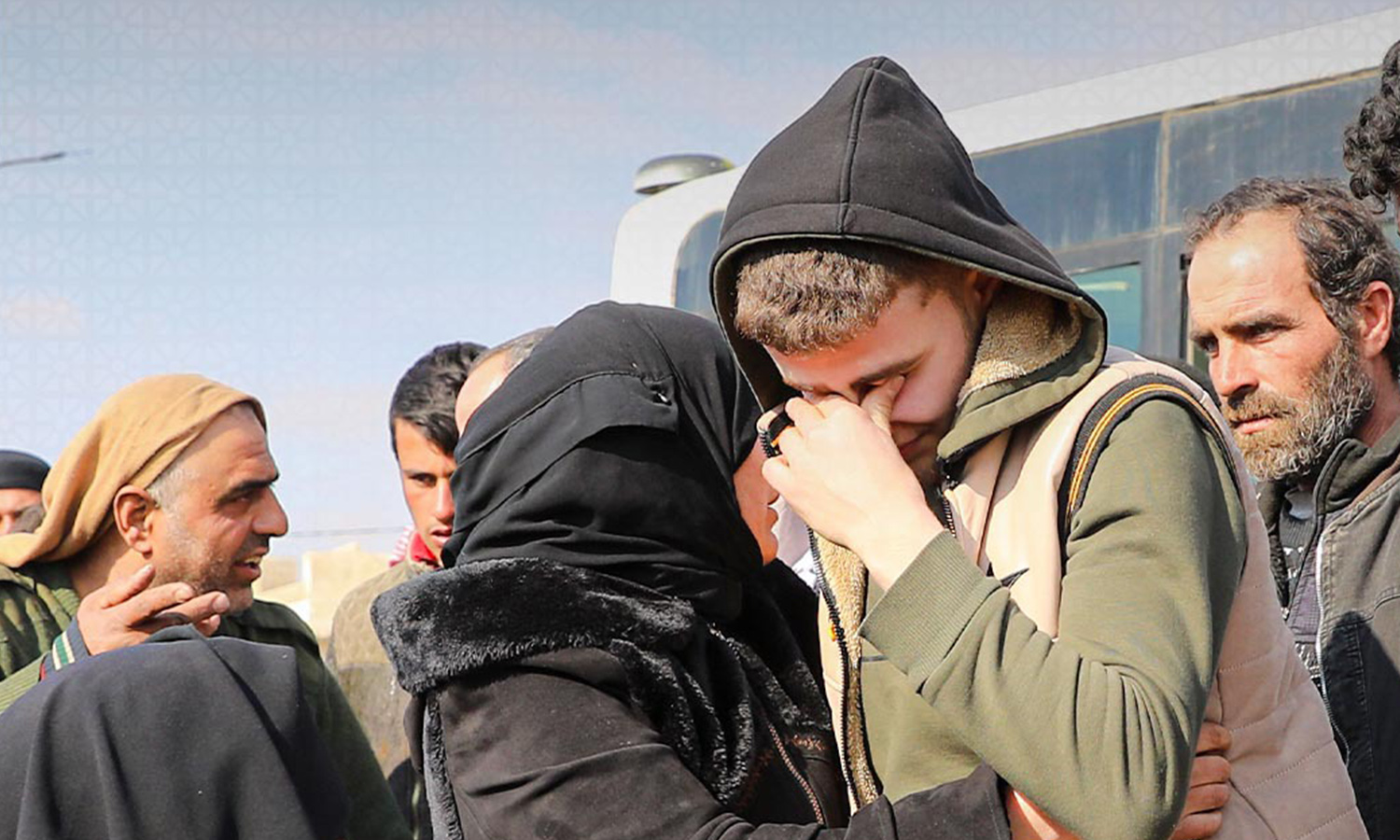
 Syrians returning from Turkey to northwestern Syria through the Bab al-Hawa border crossing following the massive earthquake that struck the region on February 6 - February 23, 2023 (Bab al-Hawa crossing)
Syrians returning from Turkey to northwestern Syria through the Bab al-Hawa border crossing following the massive earthquake that struck the region on February 6 - February 23, 2023 (Bab al-Hawa crossing)





 A
A
A
A
A
A
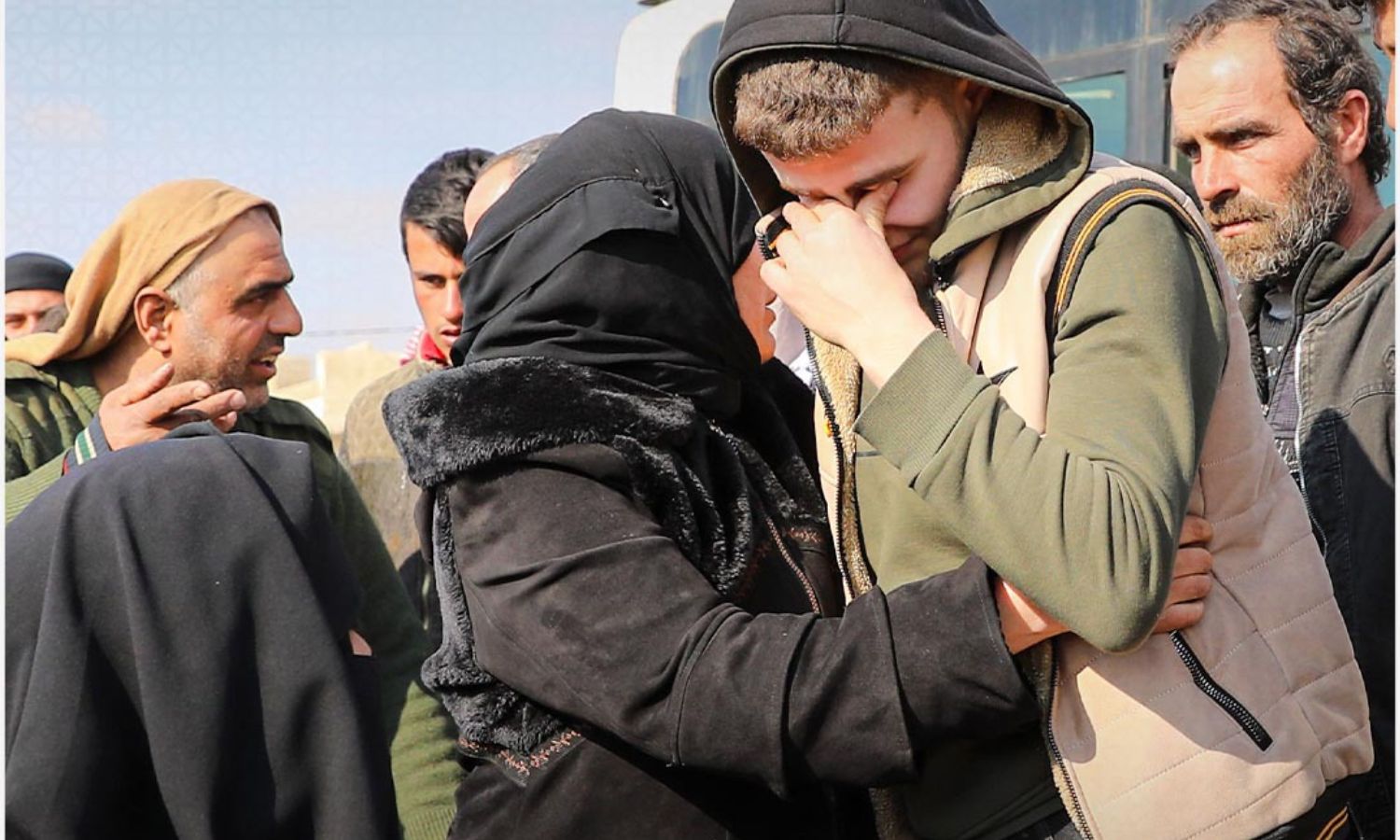
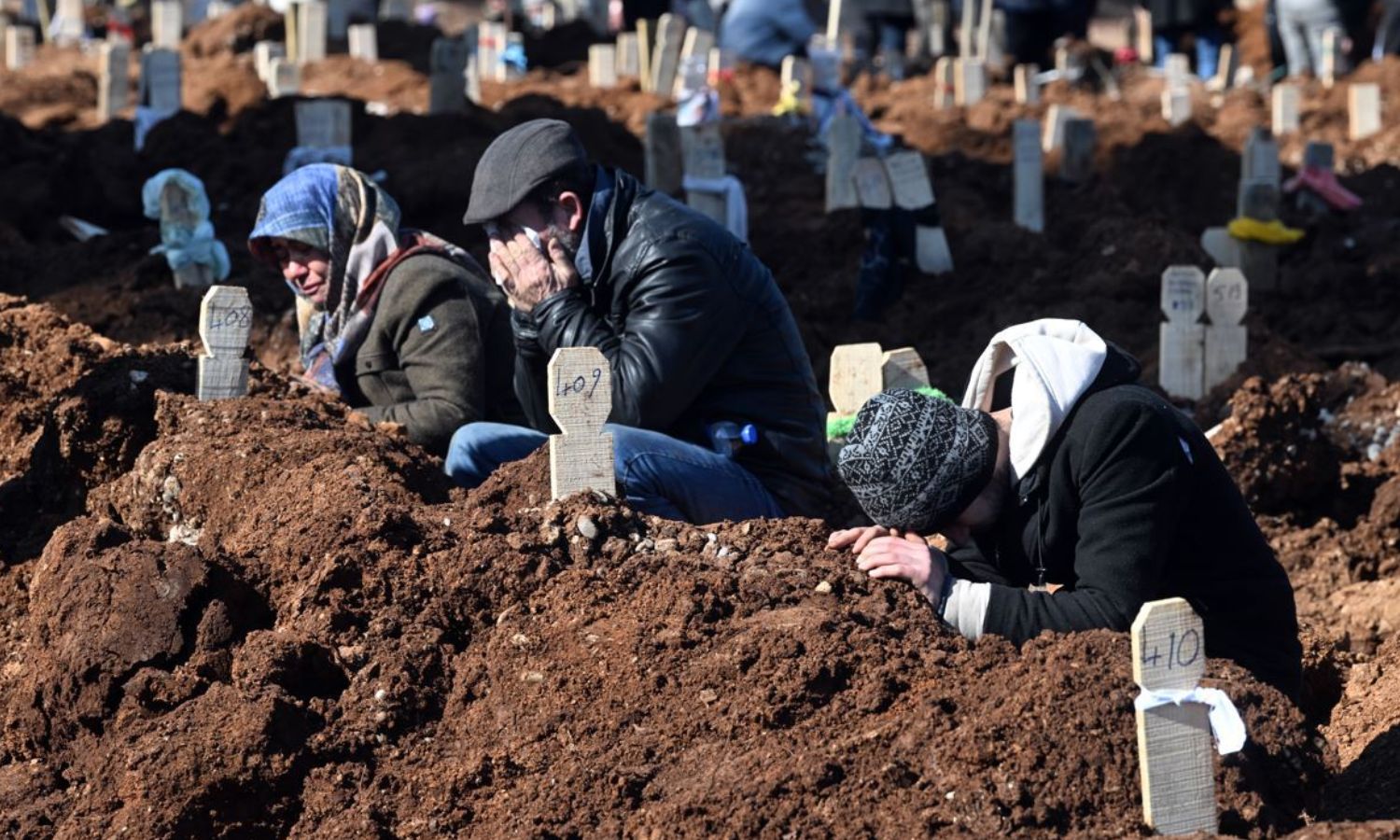
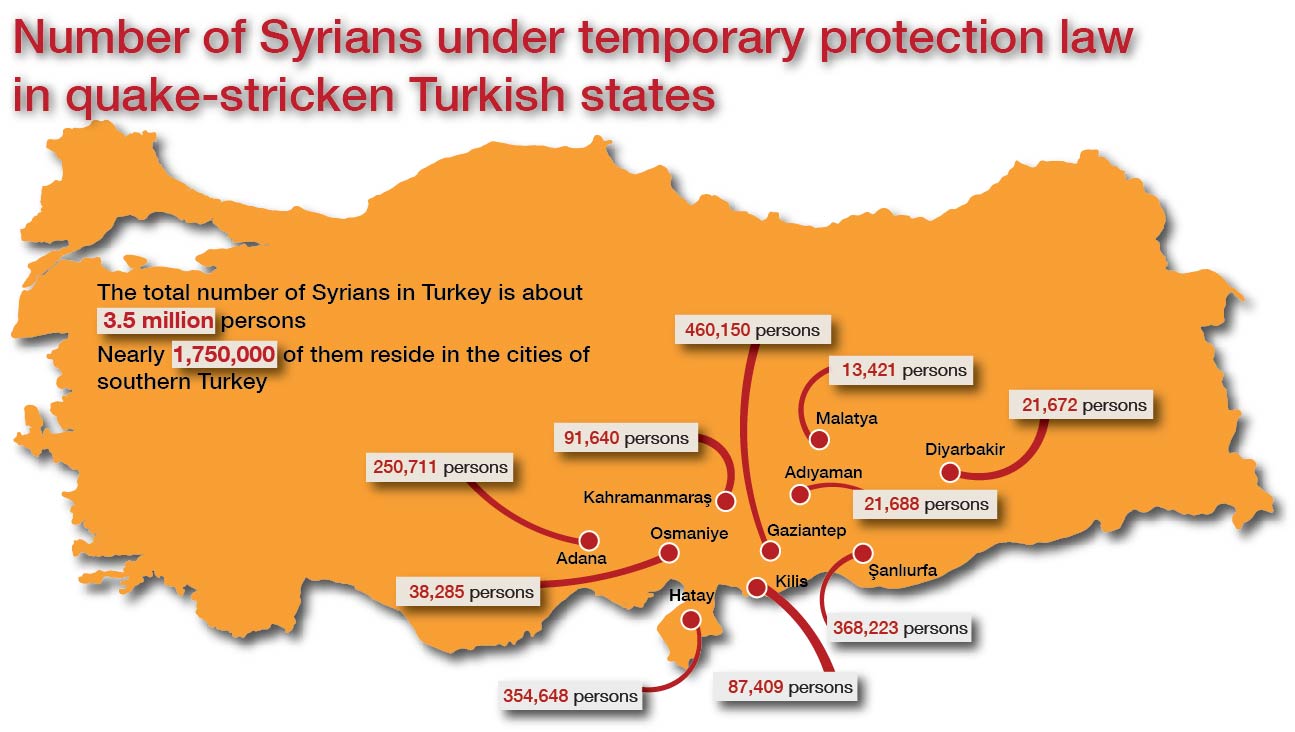


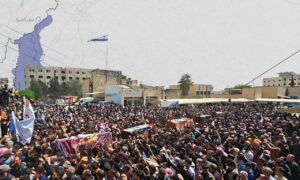




 More In-Depth
More In-Depth